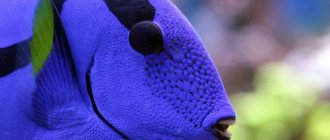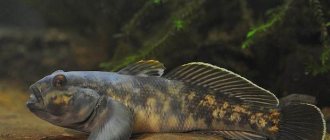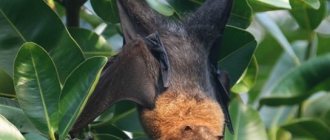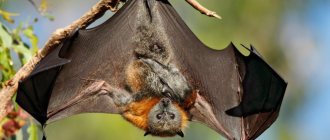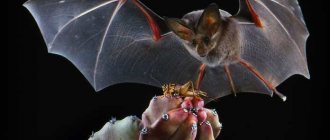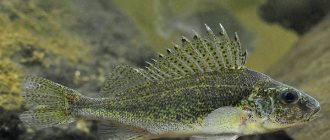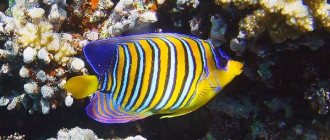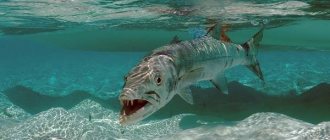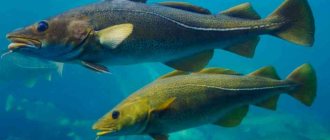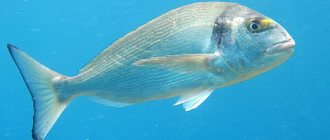In every family of animals we can find a species that behaves completely differently from other members of the taxon. One of these unique creatures are flying fish, cutting across the surface of the water like seagulls. If you watched the movie Life of Pi, you probably remember the scene when flying fish flew over the boat, and the Bengal tiger caught them with its open mouth.
Life, as we know, came to land from water, but some fish, watching the birds, thought to themselves: why don’t we fly like this...
Today we want to explain to you the phenomenon of these fish and answer the question: “Why did fish have wings?”
Appearance on Earth
Photo: World History Encyclopedia
The oldest known fossil of a flying fish, Potanichthys xingyiensis, discovered in China, dates back to the mid-Triassic period, 235-242 million years ago. However, scientists have proven that this fossil is not related to modern varieties of flying fish, which independently evolved about 65 million years ago.
Character traits
Anatomical features
The most characteristic feature of the flying fish is its unusually large, wide and high pectoral fins, which allow it to move along the surface of the water. The body shape resembles a torpedo , and the tail fin allows it to develop very high speeds under water.
Photo: Wikimedia Commons
Flying fish are able to perform flights with rapid gliding through the water, during which their pectoral fins develop, forming a kind of wings. In addition to the extremely useful pectoral fins, they are helped in flight by forked tail fins, the lower part of which is longer than the upper. Many species also have large pelvic fins with 6 rays to provide stability during flight. The dorsal fin with 12-14 rays is strongly pushed back.
Flying fish from the genus Exocoetus (diptera) are distinguished by one pair of fins and a streamlined body shape. These are very fast flyers . At the same time, representatives of the genus Cypselurus (swift tails) have a flattened silhouette and two pairs of fins, which allow them to spend maximum time in the air. Flyers from the genus Fodiator acutus (fodiators) have a sharp snout with a protruding lower jaw, while other varieties have a blunt snout.
Photo: Linda
Coloring
Flying fish have a typical contrasting color pattern that provides them with camouflage that is undetectable to predators and prey. They are dark bluish-green above and light below. Most species have pectoral fins that are brown, green, blue, or transparent. In others they are pigmented, with a dark transverse stripe or small mottled spots on a light background.
Size
Flying fish are conventionally divided into two-winged and four-winged fish. Diptera species have a length from 15 to 30 cm, and four-winged species usually grow up to 38 cm. The largest representative of the second group is the California flying fish (Cypselurus californicus), reaching 48 cm in length.
- Body length: 15-48 cm (average 17-30 cm)
- Body weight: 0.9-1 kg
How to cook flying fish
The heroine of the article is active at night, so she is often caught by fishermen after sunset. At sunset, flyers are caught, for example, in Polynesia. However, more than 50% of the catch is carried out by the Japanese. In the Land of the Rising Sun, flying fish meat is actively used in sushi and rolls. Here are some recipes:
Flying fish meat is tasty and healthy
- Rolls from 44 grams of rice, one fresh cucumber, a package of crab sticks, 200 grams of feta cheese, 4 tablespoons of rice vinegar, sheets of nori and caviar itself (from one jar). The cereal is cooked for about 20 minutes with preliminary rinsing with running water. Rice is poured into cold water. Vinegar is added to the finished, hot cereal. Then the cucumber and sticks are cut. Part of the cooled rice is laid out on nori. The farthest centimeter of the sheet is left empty. Caviar is placed on top of the rice. Then the workpiece is pressed with half of the mat and turned over. Strips of crab sticks, cucumber and cheese are placed on top of a sheet of nori. All that remains is to wrap the roll using a mat.
- Sushi with flying fish caviar from 200 grams of rice, 100 grams of tuna, 2 tablespoons of Sriracha sauce, 120 grams of caviar, a tablespoon of vinegar and the same amount of sugar. Well-washed rice is placed in cold water. It covers the cereal by 1 finger. It needs to be boiled and then mixed with sugar and vinegar. The tuna is finely chopped and marinated with sauce. All that remains is to assemble the sushi from the base (rice), tuna, processed cheese and caviar of several colors.
The heroine of the article is also considered a delicacy in Taiwan and the Caribbean. From there the products are delivered to Russia. You can find meat and caviar in stores that sell ingredients for sushi and rolls. The price of flying fish is approximately 150 rubles for a 50-gram jar of caviar and 300 rubles for approximately 100 grams of vacuum-packed fillet.
Habitat
Photo: www.agriculture.gov.bb
Flying fish live primarily in the tropics and subtropics , where temperatures rarely drop below 20 °C. Most species are distributed in the open waters of the Pacific (up to 20 species), Atlantic (16 species) and Indian (more than 40 species) oceans. Some species are found exclusively near islands and coastal areas. There are 4 species of flying fish in the Mediterranean Sea, and 7 species in the Red Sea.
Some representatives of this family are characterized by mass summer migration to the shores of the English Channel and the southern coastal regions of Denmark and Norway. The rest of the time, flying fish gather in small schools.
Migration
The overall health of the coral reefs surrounding Barbados has suffered due to pollution from ships. Overfishing in Barbados pushed them closer to the Orinoco Delta and they never returned in large numbers. Today, flying fish migrate only as far north as Tobago, about 120 nautical miles (220 km) southwest of Barbados. Despite the changes, flying fish remains a coveted delicacy.
Many aspects of Barbadian culture center around flying fish; it is featured on coins, as sculptures in fountains, in works of art and as part of the official logo of the Barbados Tourism Authority. The coat of arms of Barbados has a pelican and a dolphin on either side of the shield, but the dolphin resembles a flying squirrel, and the Barbadian passport also contains actual artistic depictions of the spotted swifttail and other species.
Like Barbados, Taiwan and other Asian cultures highly value it as a high-end fish. Not only is it a delicacy and heavily fished in Asian waters, but it is also culturally revered at festivals and celebrations. Taiwan calls its island the home of the flying fish. Every year in the spring it migrates to the warmer waters of Taiwan.
| Area | Indo-Pacific region | Atlantic Ocean | Red sea | Mediterranean Sea |
| Number of species | 40 | 16 | 7 | 4 |
Yandex pictures
Flight and swimming
Wings are a natural defense mechanism against aquatic and flying predators. When a flying fish feels threatened in the water, it jumps out of the water, spreading its pectoral and caudal fins. Having covered several tens of meters on outstretched fins, flying fish fold their fins and return under the water or bounce off its surface, often striking the water with the lower part of the caudal fin to prolong their flight or change direction.
The aerodynamic shape of the pectoral fins is very similar to the wings of a bird, and the animal uses them in a similar way: the fish can fly straight or at an angle, succumbing to the increasing wind currents generated by the combination of atmospheric air and sea currents. During swimming, the pectoral and pelvic fins are pressed against the body.
is developed to varying degrees in different species of flying fish . The flight range and time depend on the anatomical features of the fish, in particular on the number of fins and the size of the individual. Species that use pectoral and pelvic fins for flight give a head start to two-winged flying fish. And species with long fins can easily outperform species with shorter fins in terms of flight range.
- Maximum gliding speed: 80 km/h
- Maximum travel height above water surface: 6 meters
- Maximum flight length: about 200 meters (diptera species); about 400 meters (four-winged species)
Why does it fly?
Flying squirrels developed the ability to fly to escape from predators, of which they have many. They are pursued by marlin, tuna, mackerel and other larger fish.
Flying squirrels do not flap their wings to generate lift, but the buzzing sound produced during takeoff is due to flutter caused by a combination of contraction of the axial muscles during tail movement and the action of the pectoral muscles.
Alternatively, the noise may be a consequence of the passive flag-like function of the wings, resulting from their relatively rigid leading edges and flexible trailing edges.
Fun Fact: The extended, flat pelvic fins of quadripterans evolved not to increase wing area, but to function as “tail fins” or “stabilizers.”
Eating habits
Photo: VCCP
Flying fish are not deep-sea species ; they swim almost all the time just below the surface of the water in order to quickly rise into the air in case of an unexpected attack. They feed mainly on crustaceans and zooplankton, which are abundant in the upper layers of the World Ocean. Flying fish are considered omnivores because they also eat plants and small animals. Some species even prey on small fish and pteropods. In turn, they themselves can become victims of tuna, dolphins, porpoises, marlin and octopuses.
Natural enemies
Flying fish probably fly primarily to escape from predators, especially dolphins (Coryphaena hippurus) and ommastrophid squids.
As mahi-mahi (also known as dorado) chase schools of flying fish, frigate birds circle above them, waiting for their “winged” prey to break through the surface in an attempt to escape. Thanks to special fins, the fish can glide over water over considerable distances, where birds can pick it up with their hooked beaks.
Frigate birds are specialists in hunting flying fish. Because they do not have waterproof feathers, they cannot land safely on the surface of the water, and their short and weak legs are not designed for swimming in the sea. This makes air fish their ideal food.
Birds can often be found hanging around while marine predators such as tuna, dolphin and mahi-mahi are working. Thanks to their excellent eyesight and fast flight, they can easily spot the characteristic spots of spearfishing. As the dorado carry out their pursuit, some flying fish evade capture and leap into the air to escape, while the frigate birds simply wait to seize the moment.
Yandex pictures
Reproduction
The mating season usually begins in December, and the peak breeding season occurs in June. Huge flocks have been observed many times during the mating season, sometimes reaching a colony size of over a million individuals .
Flying fish spawn in the open ocean, often among algae and other aquatic plants. The reddish eggs are usually large, up to 0.8 mm in diameter. They have long sticky fibers that help attach the eggs to plants. Juveniles often take refuge under floating algae and floating debris.
Reproduction
The winged fish gather in their millions every year during the spawning season. This occurs near the surface of the open ocean. The female releases hundreds of eggs into the water so that the male can fertilize them (these eggs can be eaten by humans as edible caviar). She then attaches her fertilized eggs with a sticky thread to a piece of seaweed or floating debris.
After a few days, the fish develop growths near their mouths that help them blend in with the plants. From the moment they are born they are mostly on their own and many will eventually die from predators.
They can fly, reaching approximately 5 centimeters in length. The average lifespan of each is approximately five years.
Flying fish grow in a negative allometric manner, becoming slimmer as their body length increases.
Wing loading has a clearly positive allometric relationship with the standard length of a flying fish, as it cannot increase its relative wingspan during growth, but must taper its wings to improve performance as it flies at high speed.
Fun Fact: Flying fish have “fins” just like birds and bats, and the largest flying fish have wings similar in size to cormorants and pelicans.
Yandex pictures
Meaning to people
This unusual fish is caught in commercial quantities in Japan, China, Vietnam, India and Indonesia.
Photo: Stocksy United
In Japanese cuisine, fish is often consumed dried, and the roe of the Far Eastern longwing (Cheilopogon agoo) is used in some types of sushi known as tobiko. The roe of this fish is also the mainstay of the diet of the Austronesian Dao people of Orchid Island, located near Taiwan. Flying fish is the main ingredient in the national dish of Barbados called "coo-coo".
In the Solomon Islands, flying fish are caught during their soaring flight using special nets held in powerful outrigger canoes. The best bait for them is the light of a lantern , so fishing is carried out only on moonless nights.
Flying birds names. What types of birds fly the highest - list, characteristics and photos
their forelimbs evolved into wings, allowing them to fly. Some species, such as the black swift, spend ten months of the year in flight. They eat, sleep and even mate in the air. On the other hand, there are migratory and predatory birds that can rise to altitudes from 9,000 to 11,300 m. This article presents the ten highest flying birds in the world, with a brief description and photo.
Best articles: Hungarian Kuvasz - a dog not for an apartment
The ranking below is based on the maximum recorded flight altitudes of various bird species, which are capable of reaching incredible heights as they fly long distances in search of food and to breed.
White stork (4800 m)
The White Stork (Ciconia ciconia) is a species of migratory bird that can fly at an altitude of about 4800 m. These birds have a distinctively long neck, an impressive height of about 100-125 cm, and a wingspan of 155-215 cm. The species lives in the western part Central, but fly to South in the winter months. White storks migrate in flocks. The large wings of storks allow them to soar on warm air currents without exerting significant physical effort.
Godwit (6000 m)
The Godwit (Limosa lapponica) is a migratory bird species that spends the breeding season in Siberia and Alaska. In winter they fly to New Zealand, southern Europe and Asia. These birds feed on worms, aquatic insects, etc. Godwits hold the record for the longest continuous flight - more than 11,000 km.
Mallard (6400 m)
A migratory species of bird from the Anatidae family, which is found in Europe, but migrates to Asian countries such as India in winter. They can reach altitudes of up to 6400 m, although they are usually found at altitudes of 300-1200 m. The mallard (Anas platyrhynchos) has an average lifespan of up to 10 years, but some individuals manage to live up to 20 years.
Andean condor (6500 m)
The Andean condor (Vultur gryphus) is a large bird species, reaching a weight of about 15 kg. Lives in the Andean mountains of the continent. They are scavengers that feed on dead animals. The condor has an impressive wingspan of up to 320 cm, and can rise to a height of about 6500 m. The species is on the verge of extinction due to habitat loss and overhunting. Considered the national bird of many Latin American countries, including Chile, Ecuador and Bolivia.
Bearded Man (7500 m)
The bearded vulture (Gypaetus barbatus) lives in the highlands of southern Europe, Asia and Africa. With a wingspan of up to 280 cm, these birds can fly steadily at altitudes of up to 7500 m. They rise to great heights to drop large bones until they crumble into small fragments. The bearded vulture's digestive system is capable of digesting small bone chips within 24 hours.
Alpine jackdaw (8000 m)
Alpine jackdaws (Pyrrhocorax graculus) are birds that are perfectly adapted to the lack of oxygen at altitude. These are not only high-flying birds, but also the highest nesting birds on the planet. Alpine jackdaws build their nests at altitudes above 6,400 m. They have been recorded soaring near Everest at altitudes of up to 8,000 m.
Whooper swan (8200 m)
The whooper swan ( Cygnus cygnus ) is a migratory bird species that inhabits wetlands in Europe and Asia. Whoopers nest near lakes, ponds and wetlands. The species received this name because of its “screams.” During migration, whooper swans usually fly in "V" formations at altitudes of around 2500 m, although they are capable of reaching altitudes of up to 8200 m.
Bar-headed goose (8800 m)
Bar-headed goose (Anser indicus) is a species of migratory bird found in the mountain waters of Central Asia. These birds are able to rise to a height of up to 8800 m and fly over the mountain peaks of the Himalayas in conditions of low atmospheric pressure. During the winter months they fly south. The bar-headed goose can fly up to 1,600 km in just one day during migration.
Common crane (10,000 m)
The common crane (Grus grus) lives in northern Europe and Asia in summer and migrates to North Africa in winter. These birds fly in V-shaped flocks, even over the Himalayas. During the migration period, gray cranes rise to 10,000 m to avoid eagles in mountain passes.
African vulture (11,277 m)
Photo: Lip Kee/Wikimedia Commons The African vulture (Gyps rueppellii) is a species of bird of prey native to central Africa. Their body is adapted to extreme altitudes and low oxygen levels. The blood of the African vulture contains special hemoglobin, which absorbs oxygen much more efficiently. They rise to high altitudes not to fly long distances, but to get a better view of the area. The African vulture has keen eyesight and can detect prey from an altitude of 11,000 m.
Did you know?
- While jumping, the flying fish moves its tail up to 70 times per second.
- In May 2008, Japanese television NHK filmed a flying fish named "Ikarfish" flying for 45 seconds off the coast of Yukushima Island. The previous record holder lasted 42 seconds.
- From 1900 to 1930, the anatomical features of flying fish were studied to create prototype aircraft designs.
- In the past, Barbados was called the country of flying fish, which today are the national animal of this state.
- Flying fish often "land" on the side of boats while jumping. Once they even knocked down a crew member of the Kon-Tiki.
